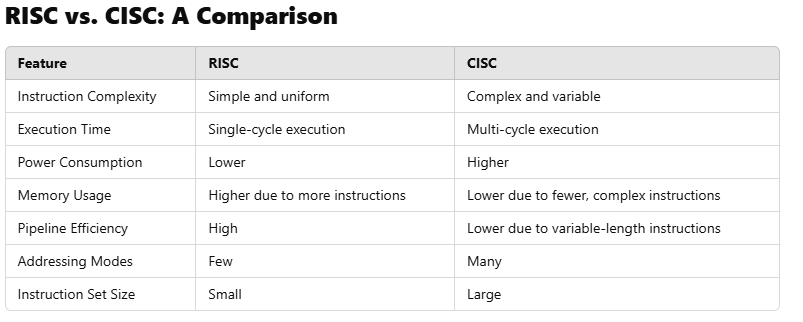Introduction
In the world of computer architecture, two primary paradigms define processor design: RISC (Reduced Instruction Set Computing) and CISC (Complex Instruction Set Computing). These architectures influence how processors execute instructions and impact system performance, power efficiency, and overall computational capabilities. This blog will explore the fundamentals of RISC and CISC architectures, their advantages, disadvantages, differences, and real-world applications.
What is RISC Architecture?
RISC (Reduced Instruction Set Computing) is a CPU design philosophy that emphasizes simplicity and efficiency. It uses a limited set of instructions, enabling faster execution by optimizing instruction pipeline performance. The primary goal of RISC is to perform instructions in a single clock cycle whenever possible, leading to increased performance and energy efficiency.
Key Characteristics of RISC
- Simple Instruction Set:
- Each instruction performs a small, well-defined task.
- Instructions typically execute in a single clock cycle.
- Load/Store Architecture:
- Memory access is limited to specific load/store instructions.
- Arithmetic and logic operations only work with registers.
- Fixed-Length Instructions:
- Uniform instruction size simplifies instruction decoding.
- Pipeline Optimization:
- Deep pipelining is used to enhance parallelism and performance.
- Fewer Addressing Modes:
- Unlike CISC, RISC minimizes the number of addressing modes to keep instruction execution simple.
- Large Register Set:
- More general-purpose registers reduce memory access latency.
Advantages of RISC Architecture
- Higher Performance: Due to optimized instruction execution and pipelining.
- Efficient Power Consumption: Less complex instruction decoding leads to lower power usage, making RISC suitable for mobile and embedded devices.
- Simpler Compiler Design: The predictable instruction set makes it easier for compilers to generate efficient code.
- Scalability and Flexibility: Easier to adapt and enhance for various applications, including embedded systems and high-performance computing.
Disadvantages of RISC Architecture
- Higher Memory Usage: Since RISC requires multiple simple instructions instead of a single complex instruction (as in CISC), programs may occupy more memory.
- Code Expansion: More instructions are needed to accomplish complex tasks.
- Dependency on Optimized Software: RISC processors require compilers that generate efficient machine code to fully utilize their potential.
What is CISC Architecture?
CISC (Complex Instruction Set Computing) is a processor design approach that focuses on executing complex instructions with fewer lines of assembly code. This means a single instruction can perform multiple operations, such as memory access, computation, and addressing modes.
Key Characteristics of CISC
- Complex Instructions:
- A single instruction can perform multiple low-level operations (e.g., memory access, arithmetic, and logic operations).
- Reduces the number of instructions needed in a program.
- Variable-Length Instructions:
- Instructions have different sizes, making decoding more complex.
- Multiple Addressing Modes:
- Supports a wide range of addressing modes to enhance flexibility.
- Microprogrammed Control Unit:
- Uses microcode to implement complex instructions.
- Memory-to-Memory Operations:
- Allows direct memory access without requiring data to be loaded into registers first.
Advantages of CISC Architecture
- Reduced Program Size: Fewer instructions mean programs occupy less memory.
- Lower Instruction Fetch Overhead: Since complex tasks are performed with fewer instructions, instruction fetch cycles are minimized.
- Backward Compatibility: Many CISC architectures maintain compatibility with previous instruction sets.
- Simplifies Software Development: Since high-level language constructs map more directly to CISC instructions, compiler design is simpler.
Disadvantages of CISC Architecture
- Slower Execution Speed: Due to multi-cycle instruction execution and complex decoding.
- Higher Power Consumption: The increased complexity of the control unit results in higher energy use.
- Difficult Pipelining: Variable-length instructions and complex operations make efficient pipelining challenging.

Examples of RISC and CISC Architectures
RISC Architectures:
- ARM (Advanced RISC Machine): Used in smartphones, tablets, and embedded systems.
- MIPS (Microprocessor without Interlocked Pipeline Stages): Found in networking equipment and gaming consoles.
- RISC-V: An open-source instruction set architecture gaining popularity in academia and industry.
- PowerPC: Previously used in Apple computers and gaming consoles like the PlayStation 3.
CISC Architectures:
- Intel x86: Dominates the personal computer and server market.
- AMD64: An extension of x86 with 64-bit computing capabilities.
- VAX (Virtual Address eXtension): An older CISC design from Digital Equipment Corporation.
- IBM System/360: A historic CISC architecture that influenced modern mainframe designs.
Applications of RISC and CISC Architectures
RISC Applications:
- Embedded Systems: Low power consumption makes RISC ideal for microcontrollers and IoT devices.
- Smartphones and Tablets: ARM-based RISC processors dominate mobile computing due to efficiency.
- Networking Equipment: Routers and switches benefit from the speed and reliability of RISC-based processors.
- Supercomputers: Some high-performance computing applications leverage RISC architectures for their efficiency and scalability.
CISC Applications:
- Personal Computers and Laptops: Most desktop and laptop CPUs use x86-based CISC processors.
- Servers and Workstations: Many high-performance servers rely on CISC processors for complex workloads.
- Mainframes: Large-scale enterprise computing benefits from CISC’s powerful instruction set.
- Legacy Systems: Older computing systems with CISC architectures remain relevant in certain industries.
Conclusion
RISC and CISC architectures represent two distinct approaches to processor design, each with its own advantages and trade-offs. RISC focuses on efficiency and performance, making it suitable for embedded systems and mobile devices, while CISC prioritizes powerful instruction sets and program efficiency, making it dominant in personal computers and servers. Understanding the differences between these architectures helps engineers, developers, and technology enthusiasts make informed decisions about processor selection for various applications.
As technology evolves, both RISC and CISC continue to adapt, with hybrid approaches emerging to combine the best of both worlds. Whether in smartphones, laptops, or data centers, these architectures remain fundamental to modern computing.
Read my other blogs:
C Program to find Given Number is Prime or not.
Write a program to find Factorial Numbers of a given numbers.
Embedded C language Interview Questions.
Automotive Interview Questions
Understanding AUTOSAR Architecture: A Guide to Automotive Software Integration
Big Endian and Little Endian in Memory
Zero to Hero in C language Playlist
Embedded C Interview Questions
Subscribe my channel on Youtube: Yogin Savani
